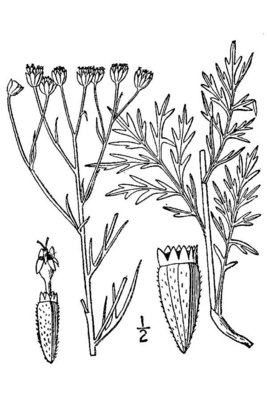
Investigation
Hymenopappus tenuifolius by Riley
1sagebrush18

Hymenopappus tenuifolius. © 2008 1sagebrush18
Lakota name: Śuηkhú śtipiye
 Listen to Lakota Plant Name: Śuηkhú śtipiye
Listen to Lakota Plant Name: Śuηkhú śtipiye
Scientific name: Hymenopappus tenuifolius Pursh
Common name: Chalk-hill woolly white
Use as a medicinal plant by the Lakota or any other culture: Made into a tea and used as salve (medical ointment) for horse hooves (Moerman 1998).
Description: Stands about a meter tall, has multiple yellow flowers and has other protective petioles, forbs/herbs.

Click on an image to view larger version & data in a new window

Hymenopappus tenuifolius. Image courtesy USDA Plants Database
Flowering: It can take 4+ years to flower in some cases.
South Dakota Distribution: Southern prairies in the state.
North American Distribution: Throughout the Midwest including SD, ND, CO, WY,KS, NE, OK, TX, and NM.
During my research I wasn’t able to find any information on potential derivatives.
Group: Dicot, Hymenopappus L'Hér.
Information on the Internet
References
Britton, N.L., and A. Brown. 1913. An illustrated flora of the northern United States, Canada and the British Possessions. Vol. 3: 506.
Moerman, D. E. 1998. Native American Ethnobotany. Timber Press.
Learning Information
- ToL Learner Level:
- Target Grade/Age Level:
- Type of Activity
- Classroom resource; Web-based resource
- Science Subject / Key Words
- Taxonomy;
- Morphology & Anatomy
- Suggested Time Frame
- It will take about 5 to 10 minutes go through this treehouse
- Sequence and Context
- This is only one lesson contained in a classroom lesson of several plants.
- Additional Treehouse Type:
- Curricular Areas:
- Language:
- Teaching and Learning Strategy:
- Inquiry Learning;
- Hands-on Learning
About This Page
Author: 1sagebrush18
Classroom Project: Medicinal Plants of the Lakota Sioux
Lead-Deadwood High School
Lead, South Dakota United States
License: Creative Commons Attribution-NonCommercial License - Version 3.0
Correspondence regarding this page should be directed to , Lead-Deadwood High School
Page copyright © 2008 1sagebrush18
 Treehouses are authored by students, teachers, science enthusiasts, or professional scientists. Anyone can sign up as a treehouse contributor and share their knowledge and enthusiasm about organisms. Treehouse contributions are checked for general accuracy and quality by teachers and ToL editors, but they are not usually reviewed by expert scientists. If you spot an error, please get in touch with the author or the teacher. For more information about quality control of Tree of Life content, see Status of Tree of Life Pages.
Treehouses are authored by students, teachers, science enthusiasts, or professional scientists. Anyone can sign up as a treehouse contributor and share their knowledge and enthusiasm about organisms. Treehouse contributions are checked for general accuracy and quality by teachers and ToL editors, but they are not usually reviewed by expert scientists. If you spot an error, please get in touch with the author or the teacher. For more information about quality control of Tree of Life content, see Status of Tree of Life Pages.
 Listen to Lakota Plant Name: Śuηkhú śtipiye
Listen to Lakota Plant Name: Śuηkhú śtipiye





 Go to quick links
Go to quick search
Go to navigation for this section of the ToL site
Go to detailed links for the ToL site
Go to quick links
Go to quick search
Go to navigation for this section of the ToL site
Go to detailed links for the ToL site